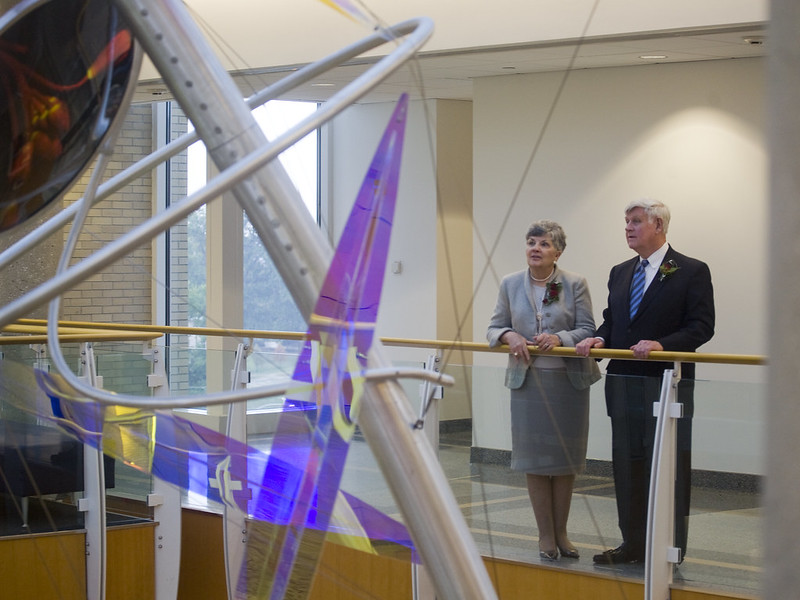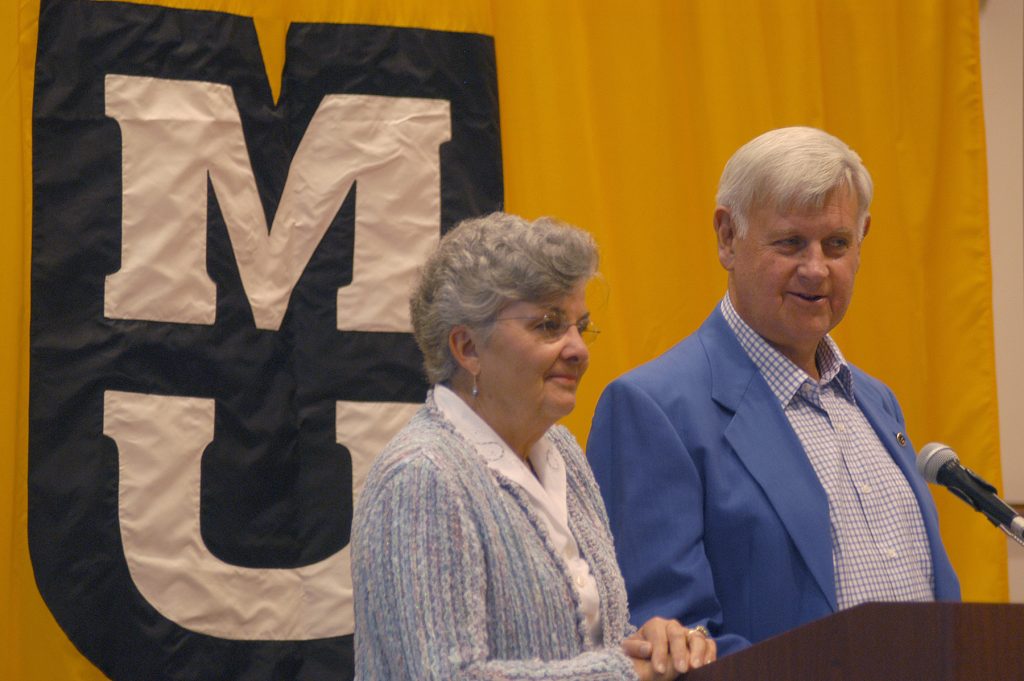
Editor’s Note: This article appeared in the 2017 issue of CAFNR’s Gratitude newsletter.
A thousand-step staircase.
That’s one way Al McQuinn tries to explain his ascent into the annals of American agriculture as an entrepreneurial and visionary businessman who holds 84 patents relating to fertilizer application.
“Each step up is based on something that happened to me, something that I was exposed to, something that I learned or something that enabled me to do the things I did,” he says.
He attributes many of those steps directly to his time at the University of Missouri in the early ’50s as an undergraduate student who paid his way through classes through a steady of line of manual labor. Eventually, his experiences at MU turned a farm boy into a pioneering salesman who helped establish the framework for what is known as precision agriculture. He would graduate with his degree in 1954 before founding his revolutionary company, Ag-Chem Equipment Company, Inc., nine years later.
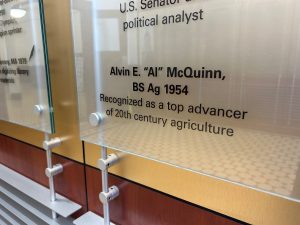
“The University of Missouri will always stand among the most appreciated and the most important ventures that I have ever experienced,” Al told the audience gathered for the inaugural Jefferson Club Golden Quill Alumni Excellence Awards on April 29, 2017, inside Jesse Hall. At the event, he became just the second alumnus from the College of Agriculture, Food and Natural Resources to have his name etched into the southern entrance of the iconic building, joining Jerry Caulder, Don Faurot and Marlin Perkins.
With all they have done for decades for MU and for CAFNR in particular, the McQuinns are charter members of the Jefferson Club. “There’s hardly a part of the college he hasn’t had an impact on,” says CAFNR Dean and Vice Chancellor Emeritus Tom Payne, adding that the support the McQuinns have given the college can easily be seen in all six academic divisions based on creating countless research and scholarship opportunities alone. “The magnification of Al’s generosity is huge.”
For the occasion in April, Al brought his wife, Mary Agnes, and two of his three daughters and their husbands. The family’s itinerary included a visit to Shakespeare’s Pizza.
“Al was so excited and it was a lot of fun watching him having so much fun taking us all there,” says Mary Jetland, Al’s oldest daughter. “We don’t get to spend much time in any of our parents’ old stomping grounds since we are all in Minnesota, so it was a such a treat to see them go back and relive stories.
“As a family we are very proud of everything he’s done for so many people. It was nice to be there to see him honored by his alma mater and to see how touched he was.”
Al was one of just five recipients of the award at the event, which was emceed by ESPN personality and MU alumnus John Anderson.
“I was honored. It’s a wonderful recognition to what I have been able to accomplish in my lifetime. I look back on it and there is not slightest reservation in my thought that I ever could have done what I did to advance agriculture without the University of Missouri,” says Al, whose accomplishments include being named one of the top agricultural innovators of the 20th Century in the millennium edition of Farm Chemicals International trade magazine in 2000. “And I think if I had gone to any other school or university that it just wouldn’t have been the same for me.”
Hello, Mr. Truman
Al McQuinn was born on Oct. 22, 1931, in Butler, Missouri, a small town a little more than an hour’s drive from Kansas City. He grew up on a cousin’s farm during the height of the Great Depression. When he was 8, his mother became a single parent, left to raise and feed Al and his two younger brothers, Morris and Donnie. At 8 years old, he found his first job delivering newspapers in his trusty red wagon – and getting a whole 10 cents a day for his efforts.
In 1942, with World War II on full boil, Al’s mother moved the family north to Independence, where she found work at an ordnance plant, running a machine that would put caps on bullets. During that time until he would leave for MU, Al found plenty of work on a farm run by a man named Roy Beets.
“He would be waiting for me when school was out on Friday evenings,” Al said of Roy. “I would change clothes and just jump right into farm mode. I did everything.” Al’s to-do list included plowing fields, running planters, cultivating corn and harvesting potatoes at 10 cents a bushel. That last job, in particular, would help grow an interest in soils – and later fertilizers – as he would take note of how poorly the crop would grow in clay-based soils when compared to the blacker soils that were rich with loam.
“That may not seem like a very big thing but it certainly implanted in my mind the variability that existed in soils,” Al says.
If Al needed any inspiration of what he could become beyond the city limits of Independence, all he had to do was look for the stately gentleman who would regularly walk down Pleasant Avenue with little to no secret service agents: Harry Truman. Al lived on that street and would often see the president-to-be on his walk to high school. Furthermore, Al would attend political fundraisers for Truman, a U.S. senator at the time looking to run the presidency, as the guest of a friend from high school whose father had organized the events.
“I would meet Mr. Truman each time,” Al says of the 33rd U.S. president. “I don’t think he ever really nailed my name down, but he certainly knew who I was and he knew me on the street, too.”
Heading to Columbia
Even though Al was the oldest of his three brothers, he ended up getting a ride to Columbia from Morris, who would follow Al’s path to MU through a track-and-field scholarship.
Upon his arrival in 1950, he joined the Farmhouse fraternity, an agriculture-based organization of young men established at MU in 1905. One of Al’s fellow freshman and pledge class members was Bob Marshall, who would go on to become the first Wendell Arbuckle Professor of Ice Cream Research at MU and the co-inventor of the famed Tiger Stripe ice cream flavor in the late ’80s. “He is a great friend,” says Bob, who adds that he would describe Al as very “imaginative, progressive and personable” to someone who has never met him.
Al recalls how Bob’s dedication to his academic pursuits in food science – and the rest of his fraternity brothers for that matter – helped inspire him to remember the top reason for coming to Columbia in the first place.
“I remember him as a top individual in his world of academia,” Al recalls of Bob. “There were other top students in the fraternity and many of them I felt were gifted to be so academically advanced in their chosen fields and I would ask myself this question: ‘Why aren’t you doing something like this?’ And the answer I gave myself, or excuse, is that I need a broad, broad base of learning to do what I want to do.”
This sentiment led him to the office of the dean of the students, Jack Matthews. As Al would explain to the man known in most circles simply as “Black Jack,” he needed to find an academic path that would build on his previously established agricultural background while providing him the tools needed to run a successful business.
Matthews proposed an academic path that would take the traditional agricultural curriculum and infuse it with a dozen or so classes representing a wide range of interests such as business law, real estate and general insurance. Although his proposal would lay the groundwork for the agricultural economics program, no one had ever made such a request. Black Jack mulled over the idea. Two weeks later, his phone rang.
“They were going to give me the latitude I needed,” Al says.
“You must have sold them on the idea, which is kind of the beginning of your salesmanship abilities,” says Mary Agnes with a laugh.
Meeting his match
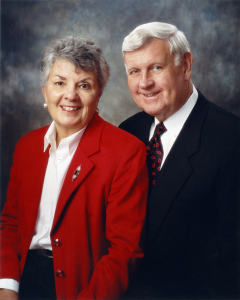
If winning over Black Jack counted as one of the more significant steps on that climb upward, winning over his wife of 63 years was an even bigger one.
Like Al, Mary Agnes had a farming background, being raised in a small town in Indiana. She had chosen to study art at what was then Christian College, an all-female school that would later change its name – and add male students – to become present-day Columbia College. At the time, the male-to-female ratio at MU was around 6 to 1, Mary Agnes says, so the female students from Christian and Stephens College “created a balance effect for college-aged people.”
“It was a really great place to be young and to go to school. It was a dreamy time in our lives, it really was, so there’s a lot of sentiment involved with Columbia,” Mary Agnes says.
In Al’s junior year, he had taken notice of a girl who had briefly dated one of his fraternity brothers. For the sake of this story, we will call him Joe. He spotted that same girl on a sunny day in September 1953 enjoying a Coke on the patio of the MU Student Union with some other girls who were dating other Farmhouse members at the time.
“I saw her… I said, ‘I’m going to marry that girl.’ This is the only second time I’ve told this story,” Al says. “I just knew.”
Knowing the unwritten rule around the fraternity, Al asked Joe on two separate occasions if it would be okay for him to ask her out to go to the first fall party that Farmhouse was throwing.
“I’m going to look around for a bit,” replied Joe.
“Sounds like it was a cattle sale,” Mary Agnes says, listening to her husband’s recollection.
And so Al ended up placing a call to her at her dormitory at St. Clair Hall, where a room with three phones had to satisfy the communication needs of more than 100 college girls. Even though Mary Agnes was not completely certain who Al was, she looked forward to seeing old friends who she had met from dating Joe. She said yes. Seconds later, Joe had called Mary Agnes back to ask her to the party. “I said sorry… That’s the way it goes, kid.”
In Al, Mary Agnes had found someone who shared a common experience of necessary maturity during childhood. She herself had helped raise her younger brother after her father passed away of a heart attack when she was 15, leaving her mother to take up his job as a journalist two weeks after his death.
“I think we both had this independent, self-reliance maybe beyond our age at that point,” she says. “He wasn’t a silly frat boy. He was serious.”
After going on several dates, Al invited Mary Agnes to that year’s Barnwarming dance. He later proposed to her at Farmhouse’s spring formal. They were married in October 1954 before Al went off to serve in the Army.
Mary Agnes says that one of the biggest joys of all of their philanthropic efforts over the years was the many trips they made to Columbia as part of the For All We Call Mizzou campaign, which Al co-chaired with Lowell Miller.
“It was so much fun after all those years to go back to that campus. Yes, it brought back memories, but it was also so rewarding to see how well the school had done and how well they were doing,” she says. “And it’s been a joy to help further that. We had a lot of fun doing that and we met a lot of people we wouldn’t have otherwise.”
Taking to the skies
After graduating from MU, Al reported for duty as part of a now-defunct compulsory Army program in which a recent college graduate could earn the status of second lieutenant provided they served for five years. Being a commanding officer, he quickly found himself on several boards and in a leadership role in which he needed to be able to talk and write with equal eloquence.
One day after feeling particularly embarrassed about his letter-writing skills, he came home and grabbed an English book and “got the English teacher over there and we started forming sentences,” Al says, pointing to his wife, whose parents were both journalists.
“He’s became a wonderful letter writer,” Mary Agnes says. “Al can learn anything if he sees that he can use it.”
“She’s got it,” Al says with a chuckle.
Although he is known for being a visionary, Al will be the first to tell you that at first he did not realize the tremendous use that having the ability to fly would have on his career. His brother Donnie was the one who wanted to be a pilot. Two years after joining the Army, though, Al enrolled in flight school largely to earn an extra $100 a month once he was instrument rated as a reconnaissance pilot.
Flying would add a literal dimension of latitude to his life: the ability to go anywhere and at anytime. It would also determine his future after being the given the order to fly a fellow officer up to Wisconsin for a family emergency in the summer of 1958. Before flying back to where he was stationed at Fort Bliss near El Paso, Texas, Al spent a few days in Minneapolis, where his co-pilot was raised. He quickly fell in love with the area and the idea of starting a family there.
At one point on that trip, Al flew about 200 feet above the green acreage in southern Minnesota and quickly realized all of the potential the area had for an agriculture-based business of some kind.
Later he found an opportunity to manage and, as he puts it, “resuscitate” a chain of fertilizer businesses, by relying mostly on his knowledge of soil variability that he learned through his various farm jobs.
Recognizing a need for more efficient farm equipment and chemicals, Al founded Ag-Chem in 1963 out of Jackson, Minnesota, a town near the Iowa border. From there he built a line of large application machines known as Terra-Gators and liquid applicators called Ro-Gators that he would then sell to farmers, mostly who were in the corn and grain industries. The company was sold to AGCO Corporation in 2001.
Using his own plane to visit clients, he would build his network of satisfied customers by first offering to leave test rows of crops using the exact prescription blend of fertilizer needed for that type of soil.
“‘You know what? I am here to make a winner out of you so I can be a winner.’ And that’s what I would say to them,” Al says. “I frankly never sold a product in my life that I didn’t think was going to be a win for my customers.”
Go forth and multiply
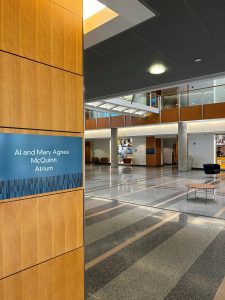
Al and Mary McQuinn have taken that same approach to their philanthropy: Donations are best when, like crops or business ventures, they can be grown.
“I don’t like to donate to entities that like to consume the money, more or less,” Al says. “If they can take it and multiply it and elevate somebody else’s life, now the money may be gone, but the substance and the benefit of the money is not.”
In Tom Payne, Al recognized a fellow entrepreneur and leader who could take a donation and then double or triple the return in investment through matches from federal agencies or individual donors. Al’s trust in Tom resulted in him establishing a fund that would give Tom the “fiscal flexibility,” in Al’s words, needed to be able to act quickly when it came to going after an opportunity or addressing an issue, such as retaining key faculty members.
“His foresight and generosity were very, very much needed and, I thought, visionary because not too many people had the flexibility he afforded us,” says Tom, who was recently asked by Al to provide opening comments for a series of interviews being done for a book about his life by the Minnesota Historical Society. The book is to be published next year.
What the lasting legacy of Al and Mary Agnes will be to the CAFNR community depends on whom you ask.
Some may think about the holiday parties that he has continued to fund – a tradition that he announced at last year’s party would continue into the tenure of new CAFNR Dean and Vice Chancellor Christopher Daubert. “I know the morale-boosting benefits of Christmas parties in my own company,” says Al, whose company had up to 2,000 employees when he served as the CEO.
Bob Marshall immediately thinks about his work with Bond Life Sciences Center, where his granddaughter, Kiley Marshall, conducts work as a junior in bioengineering. “It’s a beautiful place. There’s some of the most advanced teaching in that building… we’re not going to forget that,” he says.
One of their more noticeable contributions to the center is the massive 110-foot “Joy of Discovery” art installation, personally chosen by Mary Agnes, that hangs in the building’s center.
Fittingly, the artwork is encompassed by a large staircase, leading to a scenic view of the MU campus at the top.
